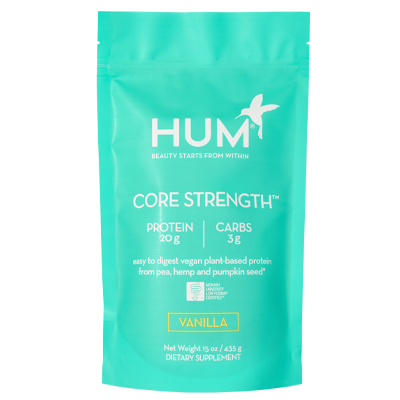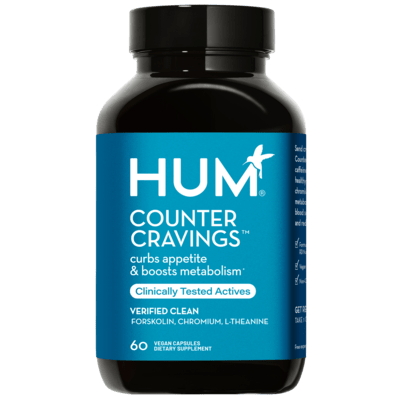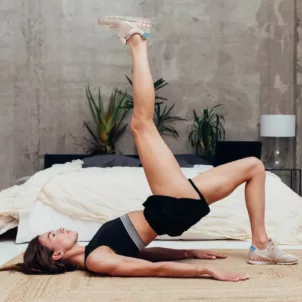HUM’s education manager, Gaby Vaca-Flores, RDN, explains what the 70/30 diet is and investigates if it’s actually proven to promote weight loss. Plus: 10 actionable tips to put this routine (or a version of it) into practice.
For many people, weight loss hinges upon a calorie deficit: calories in versus calories out. (However, other factors—including but not limited to hormonal health, blood sugar balance, and underlying medical conditions—can complicate this simplified rule of thumb.) Some opt to create a calorie deficit by dieting, exercising, or both. But does it actually matter how you go about creating this deficit?
Supporters of the 70/30 diet will tell you that successful weight loss entails a careful ratio of 70 percent diet and 30 percent exercise. But with so many approaches to weight loss, skeptics debate whether the 70/30 rule actually holds up.
Below, we’ll cover more ground on what the 70/30 diet is and what research has to say about mixing diet and exercise to lose weight.
What is the 70/30 diet?
The 70/30 diet isn’t a diet, per se—but rather the idea that 70 percent of weight loss comes from what you eat and 30 percent is influenced by exercise. In other words, a healthy diet paired with regular physical activity should create enough of a calorie deficit to help you lose weight.
While it’s not very clear as to where this idea came from, it’s likely that this concept was used to help put into perspective the impact that diet and exercise can have on weight loss.
It’s also worth mentioning that there are a few interpretations of the 70/30 rule. For instance, some people think of the 70/30 diet as eating healthy 70 percent of the time and eating, well… not as healthy for the remaining 30 percent. (This version is a variation of the trending 80/20 diet rule, which gets my stamp of approval since it’s flexible and not so restrictive.) Others look at it as eating foods that are 70 percent plant-based and 30 percent animal-based.
In any case, the 70/30 diet is typically used as a means to weight loss. (For this article, we’ll stick to the version that prioritizes 70 diet and 30 exercise.)
Does the 70/30 diet work for weight loss?
At present, there isn’t any scientific evidence that locks the 70/30 diet to exercise ratio as the gold standard for weight loss. However, the idea behind the 70/30 diet—that you can lose weight by creating a calorie deficit through a combination of diet and exercise—is well supported.
Researchers have put this idea to the test (many times) by comparing the effects of diet versus exercise, or a combination of the two, on weight loss.
To little surprise, a 2015 meta analysis of 66 weight loss studies confirms that a combination of diet and exercise is more effective for losing weight than diet or exercise alone. Another benefit of this pairing is that it’s more effective to reduce body mass and fat mass—particularly when resistance training (aka strength training) is included in your fitness routine.
While it’s great that we know that sticking to a well-rounded, healthy diet and exercising regularly are a proven power duo to help you lose weight, putting this into practice (and staying consistent with it) can be easier said than done.

How to practice the 70/30 diet
Again, the 70/30 diet doesn’t follow hard-and-fast rules or even mimic a standard diet with clear yays and nays, which may make it challenging to put into action. Instead of dwelling on how to apply this ratio to a T, I recommend making small changes to your dietary and exercise habits.
Need inspo before you get started? Here are 10 tips and modifications that can help facilitate weight loss:
- Prioritize protein at breakfast. Anywhere between 15 to 25 grams of protein will help you feel more full and have less cravings throughout the day. Whether you prefer to start your day with a smoothie or a baked treat, you can reach these intake recommendations with a protein powder, such as HUM’s Core Strength, which is vegan and low-FODMAP for easy digestion.
- Ditch sugary beverages. Making the switch to water or unsweetened tea is a simple way to save calories, all the while keeping your hydration levels up.
- Try limiting takeout to weekends only. Enjoying your takeout favorites as a treat rather than as a regular part of your menu can push you into eating fresh, home-cooked meals more often.
- Add more vegetables to at least one meal per day. In addition to their impressive nutrition profile, most veggies are also a low-cal way to fill your plate. You can add them into your routine as a side dish or mixed into a sauce, salad, or juice.
- Snack on whole foods. Real, whole foods like fruit and nuts are much better alternatives than ultra-processed foods that are often higher in saturated fats, refined sugars, and empty calories. That goes for your weight and overall health status alike. Need some extra help to support healthy metabolism and keep cravings at bay? Check out HUM’s Counter Cravings.
- Take the stairs whenever possible. Even the simplest modifications that ramp up movement can help you reach your weight loss goals. Opting for the stairs instead of the elevator is an easy way to get your heart rate up.
- Go on a 20-minute walk during your lunch break. Remember, small steps (literally) count! Walking is, without a doubt, one of the best forms of physical activity. It involves low-impact movement that can produce big results.
- Explore nearby hiking trails on the weekends. Exercise doesn’t have to be confined to a gym. Hiking, exploring the great outdoors, and finding other creative ways to get moving can help you stick to a consistent routine.
- Incorporate strength training. Strength training can help build muscle mass, which is great for your metabolism (among many other benefits). Simply put, the higher your muscle mass, the more calories your body can burn on its own.
- Set a new step goal each week. Challenging yourself to push a little further each week can help you to keep progressing rather than plateauing.
70/30 Diet FAQs
What is the 70/30 diet?
The 70/30 diet involves eating healthy, nutrient-dense foods 70% of the time, while allowing yourself to indulge in less healthy options for the remaining 30%, promoting balance without feeling deprived.
How does the 70/30 diet help with weight loss?
By focusing on healthy foods 70% of the time, the diet ensures you’re getting proper nutrients while still leaving room for occasional treats, making it easier to stick to in the long term and maintain a calorie deficit.
What foods should I eat on the 70/30 diet?
On the 70% side, focus on whole foods like lean proteins, vegetables, fruits, and healthy fats. The remaining 30% can include indulgences like sweets, processed foods, or your favorite comfort meals.
Can the 70/30 diet work for maintaining weight?
Yes, the 70/30 diet is great for maintenance because it encourages balanced eating and allows for occasional flexibility, making it sustainable for long-term health without rigid restrictions.
Is the 70/30 diet suitable for everyone?
The 70/30 diet can be adapted to most lifestyles, but it’s important to listen to your body and adjust it according to your individual health goals, preferences, and any dietary restrictions you may have.
The Takeaway
The bottom line is that the 70/30 diet isn’t actually a diet or a rule. Instead, it’s the notion that both diet and exercise are necessary for successful weight loss. While research shows that this notion is legitimate, there’s no evidence at present indicating that a 70 diet 30 exercise ratio is ideal. Nevertheless, its a good theory to keep in mind as you navigate your weight loss journey. And of course, it never hurts to make healthy eating choices and prioritize movement whenever possible, whether or not your goal is to lose weight.










